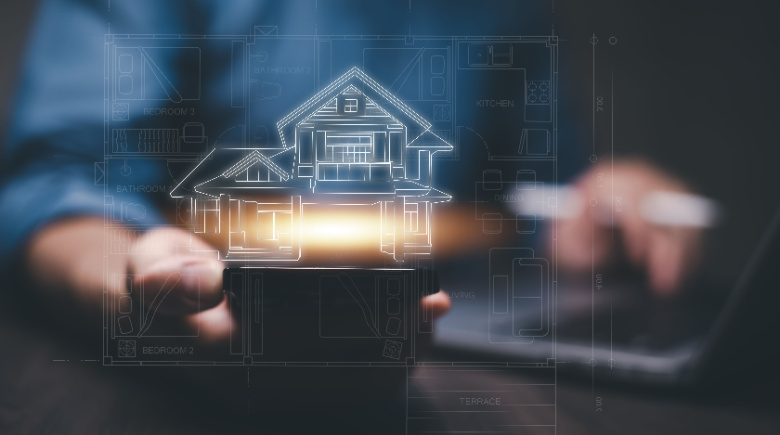The real estate industry is constantly changing because of technological, market, and socioeconomic factors. Knowing these trends is crucial for investors, homeowners, and everyone associated with the real estate market. This article explores the current trends and developments in the real estate market and what lies ahead. The trends range from the changes within homes and buildings to market shifts and the growth of cities and their effects on the real estate industry.
Technological Innovations in Real Estate
PropTech Revolution
PropTech is the integration of technology into the real estate sector, which is transforming the industry through increased efficiency and openness. Virtual reality (VR) tours enable clients to tour the properties without actually being there. Such a practice is efficient as it responds promptly to the customer’s questions and issues. It also assists in ensuring that transactions are safe and transparent, reducing fraud cases and increasing confidence. These innovations enhance the process of buying and selling properties and improve the consumer experience in real estate market transactions with higher reliability.
Smart Homes and IoT
The idea of the Internet of Things (IoT) is gradually turning homes into smart homes. Appliances such as smart thermostats, security systems, and energy management systems make life easier for homeowners as they can control appliances and check on the security system from a distance. Mechanized systems save energy; thus, the cost of the energy bills is lowered. These developments improve the standard of living and raise the worth of homes and other such possessions. This has improved home ownership as people have altered their homes to integrate IoT technologies, giving rise to smart homes.
Sustainable and Green Building Practices
Eco-friendly Materials and Designs
Environmental conservation is a vital issue in the real estate sector, leading to using green products and structures in constructing homes. Green buildings are developed in a way that least uses the resources available and, at the same time, improves the health of the population. Using photovoltaic systems, green roofs, energy-saving windows, and other structures positively impacts the environment and reduces energy bills. These sustainable practices are slowly being embraced in the construction of today’s homes since there is a rising need for green and efficient homes.
Regulatory Support and Incentives
Legal actions are being taken, and numerous countries promote green construction through incentives. Certain environmental standards that are set for some projects may be supported by tax incentives, funds and subsidies. These incentives enable the developers to integrate green measures in the buildings for the improvement of the environment and fighting climate change. Governments participate in building green structures and assist in decreasing the carbon footprint and promoting sustainable technologies. This legal framework is useful in steering the real estate sector towards sustainability, economic development and conservation of the environment.
Shifts in Consumer Preferences
Urbanization and Mixed-Use Developments
Several countries have set the stage and offered incentives for sustainable construction by formulating relevant policies. Some of the instruments include provision of tax exemptions and financial assistance in the form of grants and subsidies for those schemes that are environmentally friendly. This encourages developers to practice green development, a good step towards combating climate change globally. Public authorities support green buildings that reduce and prevent GHG emissions and the development of green technologies. This regulatory support is crucial in promoting change and improving the real estate industry in terms of sustainable development of the environment and the growth of the economy.
Remote Work and Flexible Living Spaces
The remote work trend has affected the preferences of homebuyers and convertible rooms have become popular. Today’s home buyers seek houses with a home office, an internet connection, and comfy spaces suitable for working from home. This shift is based on the need for homes that provide space for people and their worker personas and for workers’ roles in their homes. This feature is handy in the present generation where so many people work from home.
Economic and Market Trends
Market Volatility and Investment Opportunities
The current real estate market is volatile due to economic and geopolitical risks. However, this is also an investment opportunity since volatility can be good. Investors are looking for the countries that have sound economic status and are also growing at a higher rate. Special focus should be made on the markets of South East Asia and Eastern European countries as they have a great potential and stable condition of the investment environment. These areas can therefore grow their economies to stable and sustainable levels that are good for property investment. Hence, there are opportunities that are open to investors who are familiar with the market to make reasonable profits.
Affordable Housing Challenges
The issue of affordability of houses across the globe has not been fully solved even to the present time. Government and private organizations have sought solutions to this problem, including the concept of modular construction and public-private partnerships. This is because modular construction helps in the construction of houses and makes them cheaper hence suitable for the construction of affordable homes. Public private partnerships refer to the collaboration between the two sectors in the provision of better and cheaper houses. These collaborations are important in the provision of affordable houses and even better shelters in society.
Conclusion
There are various factors that have influenced the real estate industry; these include; technology, sustainability, customers, and the economy. This is a concept that investors, developers and many other professionals need to grasp and this is also a dynamic process. The variables that can be employed by the players in the real estate industry in the current environment include; technology, sustainability, and market information. When considering the future of real estate industry, it is worthwhile to note that this industry is rather promising and holds a great potential for expansion. Hence, those firms that have adopted these changes are most likely to benefit in this competitive setting.
The real estate industry is constantly changing because of technological, market, and socioeconomic factors. Knowing these trends is crucial for investors, homeowners, and everyone associated with the real estate market. This article explores the current trends and developments in the real estate market and what lies ahead. The trends range from the changes within homes and buildings to market shifts and the growth of cities and their effects on the real estate industry.
Technological Innovations in Real Estate
PropTech Revolution
PropTech is the integration of technology into the real estate sector, which is transforming the industry through increased efficiency and openness. Virtual reality (VR) tours enable clients to tour the properties without actually being there. Such a practice is efficient as it responds promptly to the customer’s questions and issues. It also assists in ensuring that transactions are safe and transparent, reducing fraud cases and increasing confidence. These innovations enhance the process of buying and selling properties and improve the consumer experience in real estate market transactions with higher reliability.
Smart Homes and IoT
The idea of the Internet of Things (IoT) is gradually turning homes into smart homes. Appliances such as smart thermostats, security systems, and energy management systems make life easier for homeowners as they can control appliances and check on the security system from a distance. Mechanized systems save energy; thus, the cost of the energy bills is lowered. These developments improve the standard of living and raise the worth of homes and other such possessions. This has improved home ownership as people have altered their homes to integrate IoT technologies, giving rise to smart homes.
Sustainable and Green Building Practices
Eco-friendly Materials and Designs
Environmental conservation is a vital issue in the real estate sector, leading to using green products and structures in constructing homes. Green buildings are developed in a way that least uses the resources available and, at the same time, improves the health of the population. Using photovoltaic systems, green roofs, energy-saving windows, and other structures positively impacts the environment and reduces energy bills. These sustainable practices are slowly being embraced in the construction of today’s homes since there is a rising need for green and efficient homes.
Regulatory Support and Incentives
Legal actions are being taken, and numerous countries promote green construction through incentives. Certain environmental standards that are set for some projects may be supported by tax incentives, funds and subsidies. These incentives enable the developers to integrate green measures in the buildings for the improvement of the environment and fighting climate change. Governments participate in building green structures and assist in decreasing the carbon footprint and promoting sustainable technologies. This legal framework is useful in steering the real estate sector towards sustainability, economic development and conservation of the environment.
Shifts in Consumer Preferences
Urbanization and Mixed-Use Developments
Several countries have set the stage and offered incentives for sustainable construction by formulating relevant policies. Some of the instruments include provision of tax exemptions and financial assistance in the form of grants and subsidies for those schemes that are environmentally friendly. This encourages developers to practice green development, a good step towards combating climate change globally. Public authorities support green buildings that reduce and prevent GHG emissions and the development of green technologies. This regulatory support is crucial in promoting change and improving the real estate industry in terms of sustainable development of the environment and the growth of the economy.
Remote Work and Flexible Living Spaces
The remote work trend has affected the preferences of homebuyers and convertible rooms have become popular. Today’s home buyers seek houses with a home office, an internet connection, and comfy spaces suitable for working from home. This shift is based on the need for homes that provide space for people and their worker personas and for workers’ roles in their homes. This feature is handy in the present generation where so many people work from home.
Economic and Market Trends
Market Volatility and Investment Opportunities
The current real estate market is volatile due to economic and geopolitical risks. However, this is also an investment opportunity since volatility can be good. Investors are looking for the countries that have sound economic status and are also growing at a higher rate. Special focus should be made on the markets of South East Asia and Eastern European countries as they have a great potential and stable condition of the investment environment. These areas can therefore grow their economies to stable and sustainable levels that are good for property investment. Hence, there are opportunities that are open to investors who are familiar with the market to make reasonable profits.
Affordable Housing Challenges
The issue of affordability of houses across the globe has not been fully solved even to the present time. Government and private organizations have sought solutions to this problem, including the concept of modular construction and public-private partnerships. This is because modular construction helps in the construction of houses and makes them cheaper hence suitable for the construction of affordable homes. Public private partnerships refer to the collaboration between the two sectors in the provision of better and cheaper houses. These collaborations are important in the provision of affordable houses and even better shelters in society.
Conclusion
There are various factors that have influenced the real estate industry; these include; technology, sustainability, customers, and the economy. This is a concept that investors, developers and many other professionals need to grasp and this is also a dynamic process. The variables that can be employed by the players in the real estate industry in the current environment include; technology, sustainability, and market information. When considering the future of real estate industry, it is worthwhile to note that this industry is rather promising and holds a great potential for expansion. Hence, those firms that have adopted these changes are most likely to benefit in this competitive setting.



